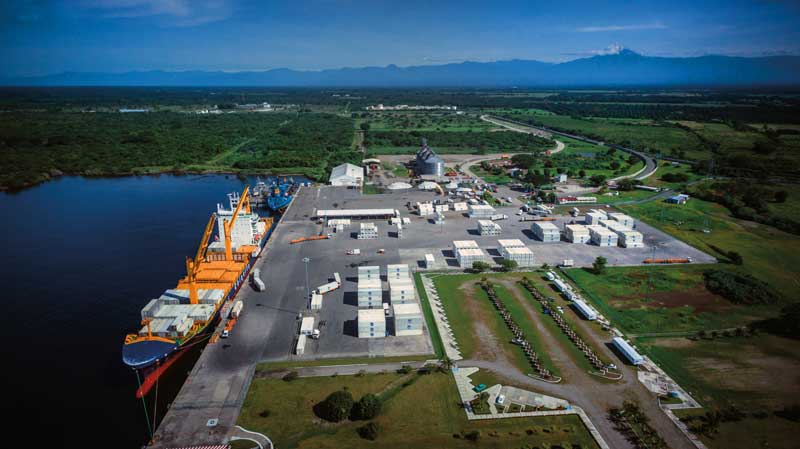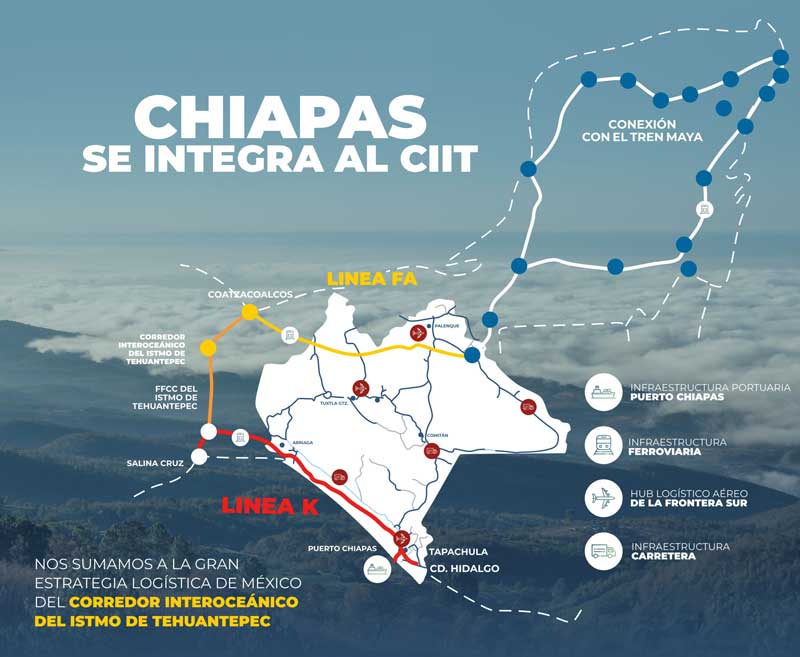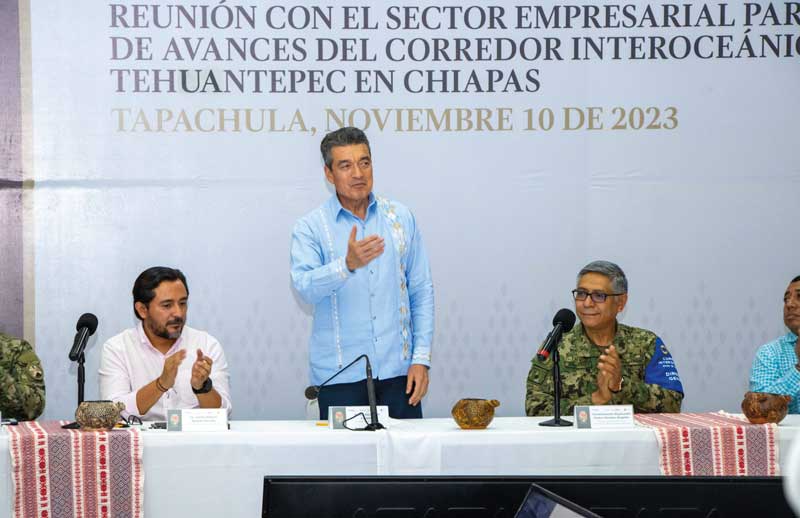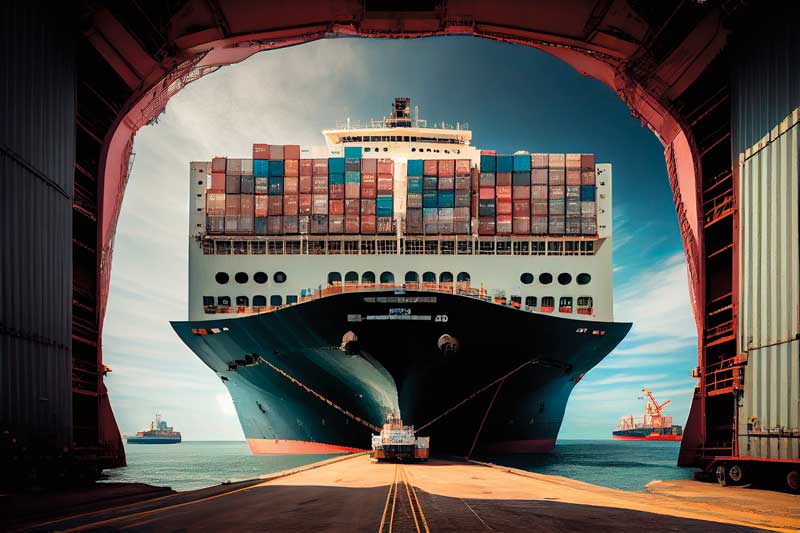The Interoceanic Corridor of the Isthmus of Tehuantepec (CIIT) is considered the catalyst for the economy in the South-Southeast region of Mexico. As Carlos Alberto Salazar Estrada, Secretary of Economy and Labor of the State of Chiapas acknowledges, it represents a great opportunity for the state to increase its industrialization with an emphasis on agro-industrial activities and the development of clean technologies and renewable energies.
"The CIIT not only focuses on logistical improvements but also projects itself as a key catalyst for increasing industrialization in Chiapas," comments the official. "The modernization of logistical infrastructures, such as Puerto Chiapas and the railway system, along with the creation of strategic industrial parks, will provide a conducive environment for various industrial activities."
REM: What economic and social importance will the CIIT project have for the state of Chiapas?
CASE: In Chiapas, we face the challenge of improving the quality of life and offering development opportunities to our population. To achieve this, since the beginning of Governor Rutilio Escandón Cadenas' administration, we have undertaken the commitment, from the secretariat under my charge, to promote and foster investment and economic development. Our state has the potential to become an attractive investment destination, thanks to key factors such as its geographic location, diversified economy, and competitive advantages.
However, to materialize these opportunities in the medium term, it was necessary to achieve profound actions and changes in our economic structure, to speak of a before and after in Chiapas. Today, we can say and celebrate this significant step forward, as after the efforts made by this government, and of course, the will and vision of the President of the Republic, on March 14, 2023, with the decree published in the Official Gazette of the Federation, Chiapas was integrated into the great national project, the Interoceanic Corridor of the Isthmus of Tehuantepec, thus marking the beginning of the development of the logistic and industrial infrastructure of our state in a transcendental manner.
REM: How can Chiapas take advantage of all the infrastructure being generated around the CIIT?
CASE: Firstly, it's important to clarify that Chiapas' integration into the corridor represents the modernization of our railway infrastructure and Puerto Chiapas, as well as the inclusion of Tuxtla Gutierrez and Tapachula International Airports in the corridor's commercial strategy, and the implementation of Welfare Development Poles.
Given the modernization of the railway infrastructure, totaling 782 kilometers, which accounts for 78% of the total CIIT project, the K line from Ixtepec to Ciudad Hidalgo, and the FA line between Coatzacoalcos and Palenque, Chiapas, will allow us to be connected from the Pacific to the Gulf of Mexico and from the border with Guatemala to the entire national railway network and the international network of the United States and Canada.
I would like to emphasize that, given our geographic location, the development of this infrastructure opens up opportunities for potential investors to tap into the Central American market, representing more than 50 million potential consumers. This represents an opportunity for various sectors, primarily agriculture and agro-industry, as well as manufacturing and sustainable tourism, which can benefit from this improved connectivity.
In addition to this, federal investment in Puerto Chiapas with the aim of ensuring its operation by maintaining a depth of 11 meters throughout the Navigation Channel and the Turning Basin, consolidates it as a key port logistics platform in southern Mexico that will undoubtedly strengthen the exports of Chiapas products and open up new markets on the east and west coasts of the United States.
Furthermore, we work under an integral system to attract investments through a strategy based on five fundamental pillars: logistical and industrial infrastructure, innovation and technology, human capital development, economic intelligence, and the promotion and consolidation of investments. This has allowed us to drive projects such as a state agency for investment promotion, the establishment of a development center for industry solutions and talent called Hub Tech Talent, the implementation of the first agro-industrial cluster, activation of an economic intelligence area, and the construction of a digital transformation model for the State.
REM: What logistical and industrial projects does Chiapas promote? Can they be linked to the CIIT?
CASE: Considering the key pairing for economic development between having infrastructure and attracting investments, leveraging this opportunity, the state government has implemented actions to complement and boost the logistical and industrial infrastructure promoted by the CIIT.
We have rehabilitated the Puerto Chiapas Strategic Fiscalized Zone, which boasts a strategic location just 10 km from the Tapachula International Airport and is connected via a fiscal bridge to Puerto Chiapas. Currently, this space offers available land for industries involved in transformation and foreign trade activities that wish to establish themselves, benefiting from incentives provided under this regime, which include exemption from paying foreign trade taxes, compensatory duties, and VAT.
From the state government, in collaboration with various institutions, significant projects in logistical and industrial matters are being developed, under the management of the Operating Society at the Ángel Albino Corzo International Airport.
The second phase of expansion of the terminal building in the international area is currently underway, aligned with the airport's development master plan in accordance with the provisions of the Federal Civil Aviation Agency. By the end of 2023, the airport served nearly 1.8 million passengers, and it is estimated that it will cater to over 2 million passengers in 2024.
Furthermore, by the end of February, the Terminal and Cargo Hangar along with its Runway will be inaugurated, making us the 10th entity to possess such infrastructure. This facility will host areas for fiscal storage and cold storage, where all products requiring customs or fiscal processing will be stored, in addition to spaces dedicated to specialized air cargo companies. At the same time, construction will commence for the first logistical and industrial park, with an initial investment of 200 million pesos (mdp), covering an area of 60 hectares, and estimated to be completed by July 2024.
With these actions, this airport aims to become the aerial logistics hub of the southern border. In addition to the aerial logistical development, the modernization of the Tapachula International Airport was carried out, expanding its operational capacity and increasing the terminal building by 150%, now with a capacity of 500,000 passengers per year.
Furthermore, we managed to secure the signing of a grant agreement between the State Government and the United States Trade and Development Agency (USTDA) for the feasibility studies for the construction of an intermodal railway terminal in the municipality of Tapachula. This is undoubtedly a key complement to the work being carried out by the CIIT.
REM: Puerto Chiapas will be linked to the CIIT project. What public and private investments are being made to expand and modernize it?
CASE: In terms of public investment, we have a portfolio of modernization projects totaling around one billion pesos (mdp). These include dredging to ensure a depth of 11 meters in the navigation channel, extension of railway infrastructure, rehabilitation of cruise and multipurpose docks, construction of an administrative building, and a perimeter wall.
Additionally, in terms of private investment, there are projects such as a Multipurpose Terminal, pipelines for the transportation of petroleum products, infrastructure for vegetable oils, and a fishing dock terminal, all with an estimated investment of over 800 mdp.
REM: Will it be a complement to the Port of Salina Cruz or competition?
CASE: Puerto Chiapas will be a complementary port to Salina Cruz. Due to its geographic location and being Mexico's first maritime port with Central America, rather than competition, it will be a logistical hub that adds competitive advantages to the Interoceanic Corridor.
REM: The Interoceanic Railway will connect to Chiapas via the K line. What benefits will this bring?
CASE: The connectivity will be improved to boost both national and international trade, regional economic growth, and attract a greater number of companies and investors to settle in Chiapas. This will result in increased job creation, cost savings in transportation of goods, as well as integration into the national railway network of the United States and Canada. This opens up significant opportunities in foreign trade, as it connects us from the border to the southeast, and to the central and northern regions of the country, as well as the United States and Canada.
Additionally, it will enable the promotion of trade with Central America, which currently represents a highly significant movement. Through the Ciudad Hidalgo Customs, more than 5 billion dollars' worth of goods are moved.
Here, I would like to emphasize that this infrastructure has been out of operation due to the ravages caused by a natural phenomenon, practically since 2005. This means that it has remained unused for almost 20 years, and unfortunately, no measures were taken by various federal governments during this time.
It was only during this administration that our requests were heard, and we were included in this significant project. With the improvement of this infrastructure, we will connect with the corridor from the Guatemala border through the rehabilitation of over 400 km of tracks, allowing for circulation at a Class 3 track speed, with an average of 80 km per hour.
REM: There is mention of the possibility that at least one Development Pole (PODEBI) will be in Chiapas soon. What economic effect would this have on the region?
CASE: Indeed, the Interoceanic Corridor is currently working on the proposal to create the first two Development Poles in Chiapas, each tentatively covering 200 hectares and bordering Puerto Chiapas. This represents the foundation for the industrial impulse and development in our state. In addition to the infrastructure for business establishment, developers, industries, and SME suppliers will benefit from fiscal incentives, primarily ensuring a 100% reduction in ISR (Income Tax) for the first three years and up to 90% in the following three years, exemption from VAT for four years, and accelerated depreciation of 100% of fixed asset investments for 6 years.
Additionally to these incentives, in collaboration with the State Congress, the municipalities within the influence area of the CIIT were granted the authority in their respective municipal income laws to provide fiscal benefits to promote and incentivize private investment.
REM: What economic vocations do you consider could be fostered in the PODEBIs of Chiapas?
CASE: Within the framework of the Welfare Development Poles in Chiapas, several strategic economic vocations have been identified with the potential to drive growth and improve the quality of life in the region. Firstly, the promotion of sustainable agro-industry stands out, leveraging Chiapas' rich biodiversity to foster the production of high-quality food. Implementing innovative and sustainable agricultural practices can boost productivity and generate employment in the sector.
Another key economic vocation is the development of clean technologies and renewable energies. Transitioning to more sustainable energy sources can not only reduce the region's environmental footprint but also create jobs in the green energy sector and position Chiapas as a leader in this field.
REM: What infrastructure does it currently have, and what infrastructure will need to be included in the Comprehensive Development Plan?
CASE: In Chiapas, we have four-lane highways - toll-free - along the entire parallel line to the CIIT; Puerto Chiapas is the major port in southern Mexico, its strategic location allows for significant connections with countries in Asia and the Americas; it has four terminals: Multipurpose, containers, agricultural bulk, and fishing; Navigation channel with a depth of 11 meters, within a radius of 20 km converge the border with Guatemala, the Tapachula International Airport, as well as the road and railway network connecting all of Mexico. A Strategic Fenced Enclosure in Puerto Chiapas, where the introduction of goods (for up to 5 years) is allowed, with tax advantages for Foreign Trade (tariffs, VAT, and compensatory fees). Additionally, we have two international airports, Tapachula and the Ángel Albino Corzo International Airport, which have grown and expanded their capacity.
Text:Real Estate Market & Lifestyle
Photo: ALIANZA / Real Estate Market & Lifestyle








